
Phenex Syringe Filters
LC/GC Approved Syringe Filters
Phenex syringe filters are designed for efficient and rapid filtration of almost any solution prior to analysis, and are optimized for superior flow rates and high-throughput. Proper syringe filter membrane and size selection is the key to choosing the best product to maintain the integrity of your sample components as well as to protect your system from particulate contamination. Phenex offers a wide variety of membranes ideal for any application.
Try our Phenex Syringe Filters for:
- High quality filtration product
- Increased column lifetime
- Less system downtime
- Low protein absorption

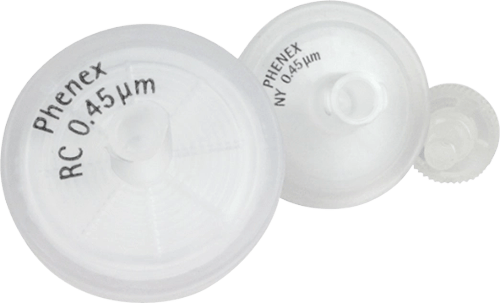
Phenex Offers:
- Broad chemical compatibility
- Minimized extractables
- Excellent flow rate
- High total throughput
- Certified quality
- 100 % integrity tested
- Low hold-up volume
- Low protein adsorption
- Bi-directional use
Maximum Quality
A: Identification
Syringe filter membrane type and pore size are clearly marked on each syringe filter
B: Luer Lock Inlet Tip
Secures connections to prevent “blow off”
C: Sample Distribution Rings
Creates even sample distribution for high sample flow rates
D: Medical Grade Polymer Housing
Offers the most inert syringe filter and helps eliminate unwanted secondary
interactions with the filter housing
E: Ultrasonically Welded
Ensures robust housing - filter integrity
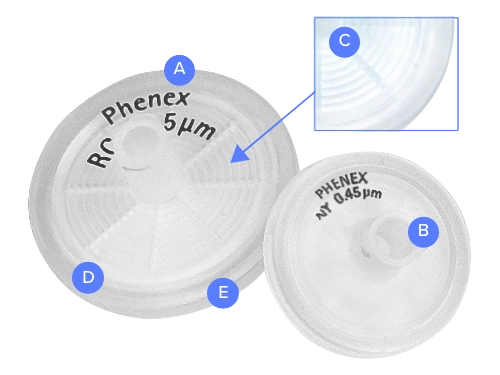
Guaranteed Reliability and Consistency
Quality filtration products from Phenomenex offer a convenient way to clean up your samples - for improved analytical results with a simple method. Phenex syringe filters are designed for efficient and rapid filtration of almost any solution prior to analysis, and are optimized for superior flow rates and high-throughput. Phenex offers a wide variety of membranes ideal for any application.
- High quality filtration product
- Increased column lifetime
- Less system downtime
The housing attaches to any standard luer lock syringe, so the sample can easily be pushed through the membrane with minimal pressure. The result is a particulate-free eluent that is ready for use with LC, GC, or other analytical techniques. One of the most popular sample preparation methods is filtration using a sample preparation solution. It has the ability to remove particulates before injection onto the column and the ability to use it in parallel with another sample preparation technique. It requires no method development.
A: Particulates Trapped
B: Particulate-free Sample
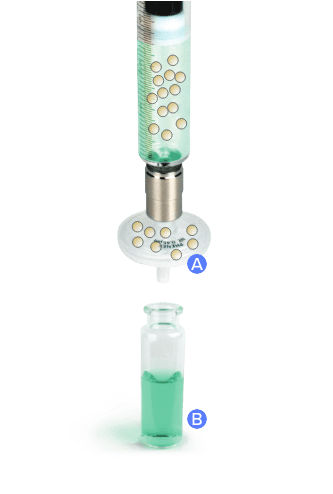
Most Popular Filter Membrane Options
| RC (Regenerated Cellulose) For Aqueous and Mixed Organic Solutions |
PTFE, Teflon® (Polytetrafluoroethylene) For 100 % Organic Solutions |
|---|---|
|
A broad range of aqueous and mixed-organic solutions
|
Well-suited for the clarification of non-aqueous samples
|
|
Fast-flow and ultra-low protein and non-specific binding characteristics
|
Hydrophobic membrane, excellent for filtration of organic-based, highly acidic or basic samples and solvents
|
|
Broadly recommended as an excellent general purpose/high-performance sample filter for most applications
|
A hydrophobic membrane, that can be made hydrophilic by wetting with alcohol and then flushing with deionized water
|
Additional Syringe Filter Membranes
| Membrane Types | Recommended Uses |
|---|---|
|
PES
(Polyethersulfone)
|
Polyethersulfone membranes exhibit very fast-flow and ultra-low protein binding characteristics.
Phenex-PES membranes are typically broadly recommended for filtering critical biological samples, tissue culture media, additives and buffers. |
|
NY
(Nylon)
|
Nylon has inherent hydrophilic characteristics and works well for filtration of many aqueous and mixed-organic samples. In combination with a glass pre-filter (Phenex-GF/NY), this membrane is excellent for the filtration of particle-laden samples, such as foods and beverages, environmental, biofuels, and dissolution samples.
|
|
CA
(Cellulose Acetate)
|
Cellulose Acetate (CA) membranes exhibit ultra-low protein binding and are broadly used in the filtration of biological samples. In combination with a glass pre-filter (Phenex-GF/CA), this membrane is excellent for filtration of tissue culture media, general biological sample filtration and clarification.
|
|
GF
(Glass Fiber)
|
Glass Fiber (GF) filters are made of inert borosilicate glass and have a nominal 1.2 µm pore size. They are commonly used with highly viscous samples or samples containing high concentrations of particulate matter (e.g., food analysis, biological samples, soil samples, fermentation broth samples, removal of yeasts, molds, etc.).
|
|
PVDF
(Polyvinylidene Fluoride)
|
Hydrophilic PVDF membrane provides high flow rates and throughput, low extractables, and broad chemical compatibility. This membrane binds less protein than nylon or PTFE membranes.
|
Recommendation Based on Your Industry
Environmental
Water, wastewater, soil and sludge, and pollution control samples are especially challenging. No matter the sample type, Phenex offers filtration products to meet your demanding requirements.Recommended Filter: GF/NY
First Alternative: RC

Pharmaceutical / Biotech
At every stage of the drug discovery process target compounds must be isolated, purified, and prepared prior to testing. Sample complexity in DMPK work can be even more challenging. Difficult samples such as serum, urine, and other physiological fluids are easily filtered and clarified using Phenex syringe filters.Recommended Filter: PES
First Alternative: RC
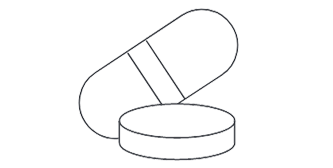
Clinical / Toxicology
Removal of particulate matter to sub-micron levels is critical before any clinical sample is injected into an LC, GC or mass spectrometer. At every stage in toxicology, samples should be filtered, preferably with a rapid and simple sample preparation method to reduce downtime in the fast paced environment. Phenex is designed for higher flow rates and throughputs than those of competing products.Recommended Filter: RC
First Alternative: PES

Food and Beverage
Food safety is more important than ever and lower detection limits are making analysis even more challenging. Accurate and reliable testing is critical and Phenex filters are routinely used in preparation for analysis of pesticides, herbicides, fungicides, flavors, and fragrances. For samples with large amounts of particulate and/or large fibrous matter, use a glass fiber prefilter.Recommended Filter: GF/NY
First Alternative: RC

Other Applications:
| Application / Sample* | Recommended Filter** | First Alternative |
|---|---|---|
| General GC and LC | RC | PTFE |
| Aggressive or Pure Organic Solvents | PTFE | RC |
| High Particulate Loads | GF/NY | GF + RC |
| Dissolution Testing | GF/NY | RC |
| Ion Chromatography | RC | PES |
| Trace Metals (ICP-MS, AAS) | RC | PES |
| Capillary Electrophoresis (CE) | RC | PES |
| Tissue Cultures, Media, Buffers | GF/CA | PES |
* Removal of high particulate matter with a glass fiber prefilter is critical before any drug, tox, or dirty environmental sample is filtered to ensure the highest syringe filter membrane performance.
** For high load and particulate-laden samples you may consider placing a Glass Fiber (GF) prefilter, either integrated with the membrane as one unit (Phenex-GF/NY or -GF/CA) or in series with the membrane syringe filter of your choice. Generally, 0.45 µm porosity filters are used to remove particulates from samples and mobile phase solutions. For sterile-filtration, a 0.20 µm porosity filter can be used.
How to Use Phenex Syringe Filters
Easy to assemble and even easier to get consistent and particulate-free samples
Step 1: Load
Fill a syringe barrel with the liquid sample. Allow a small amount of air (approximately 10 % of the sample volume) to enter the syringe. The air is used as a purge to minimize fluid retention when expelling the sample from the syringe (Step 3 below).
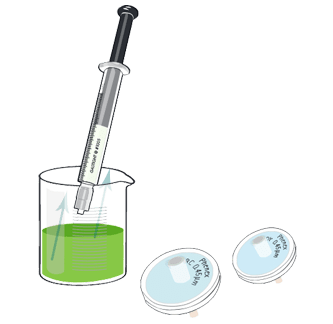
Step 2: Assemble
Twist the luer lock end of the filter securely onto the syringe.
(Caution: Do not use syringes without a matching luer lock, otherwise the pressure applied may cause the filter to come off unexpectedly.)
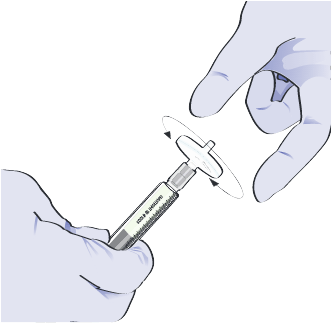
Step 3: Filter
Apply gentle pressure to the syringe plunger.
(Caution: Small syringes can generate excessive pressures.) Push the liquid sample, as well as the remaining air, through the syringe filter to maximize sample recovery.













